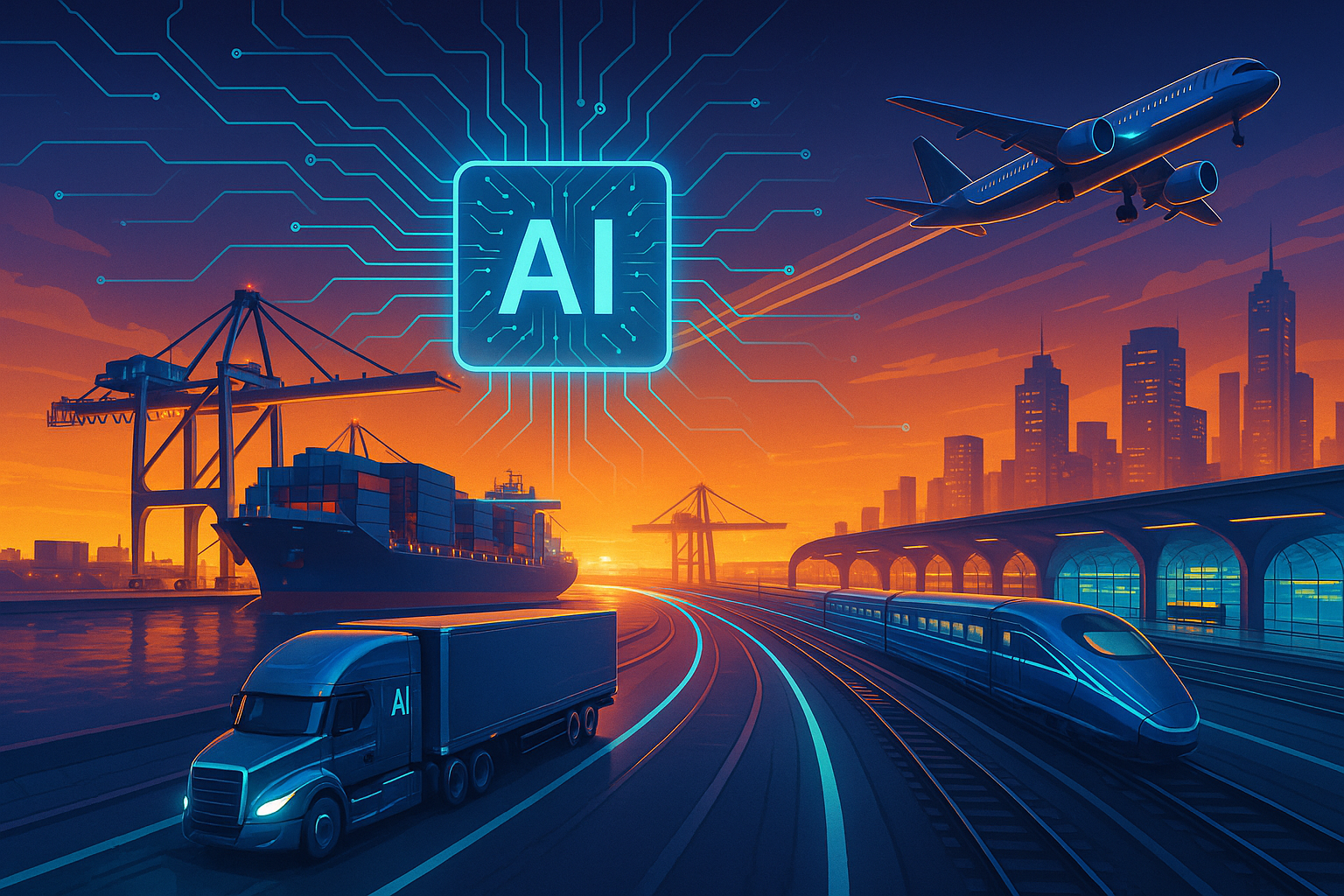AI Is Rewiring Transportation: What’s Real in 2025 (and What Matters)
September 8, 2025
Share this Article:
Artificial intelligence has moved from pilots to profit centers across trucking, rail, maritime, aviation, ports, and warehouses. Below is a quick tour of the advances that are already changing how freight moves—and the practical implications for operators, shippers, and compliance teams.

Road freight: autonomy, safety and smarter networks
- Driverless trucking milestones. Aurora launched a commercial driverless lane in Texas this spring and is expanding nighttime operations and new routes, with integrations into mainstream TMS workflows (e.g., McLeod) to let shippers plan autonomous moves inside familiar tools. AxiosReutersTrucking Dive
- ADAS keeps getting mandated. In the U.S., NHTSA finalized a rule to make automatic emergency braking (AEB) standard on new light vehicles by 2029; a heavy-truck AEB mandate is proposed. Studies show AEB can cut rear-end crashes for large trucks ~41%. The EU went further in 2024, requiring a broader ADAS suite (ISA, AEB, lane-keeping, etc.) on new vehicles. NHTSAFederal RegisterRegulations.govEUR-Lex
- Network & pricing optimization. Carriers and integrators are using AI to steer volume, plan assets, and hedge disruptions; at UPS, AI-powered Network Planning Tools optimize flows and costs and even plan around weather. United Parcel Service, Inc.
Rail: computer vision and AI on the right-of-way
- Inspection portals at speed. Norfolk Southern and Georgia Tech built machine-vision portals that image trains from all sides at up to 60 mph and flag defects in minutes—scaling across the network post-2024. GTRIGeorgia Tech ResearchAP News
- AI cruise control for locomotives. Wabtec’s Trip Optimizer, an energy-management system, has surpassed a billion auto-miles, contributing substantial diesel savings industry-wide. Wabtec CorporationTrains
Maritime & ports: from collision-avoidance to digital twins
- Safer navigation, lower fuel. Orca AI-equipped fleets reported fewer safety events and measurable fuel/CO₂ reductions through steadier speed profiles. maritime-economies.eu
- Port AI upgrades. The Port of Los Angeles is enhancing its Wabtec-built Port Optimizer with an AI-assisted appointment system and emissions visibility, funded by a 2024 grant. Rotterdam is building a port-scale digital twin to enable smarter—and eventually autonomous—vessel movements. Port of Los AngelesSupply Chain DivePort of Rotterdam
Warehousing & last mile: AI everywhere
- Slotting and orchestration. AI-driven slotting and demand-aware pick pathing are cutting travel time and boosting throughput; industry benchmarks and reports show rapid 2025 adoption alongside robotics. videos.mhi.orgOPEX
- Platform intelligence. Visibility/TMS providers (project44, Flexport) are shipping “decision intelligence” and gen-AI copilots so planners can ask natural-language questions and get recommended actions. Logistics ManagementPR Newswire
- Big retail logistics. Amazon is pushing agentic, multi-task warehouse robots and gen-AI mapping aids for drivers—aimed at seasonal spikes and delivery precision. Reuters
Aviation: AI under a safety microscope
- Regulators set the guardrails. The FAA’s first AI Safety Assurance Roadmap lays out how AI can be used for safety (e.g., predictive maintenance, anomaly detection) and how AI itself will be assured. Federal Aviation Administration
- Predictive maintenance at scale. OEM/airline platforms (e.g., Airbus Skywise) continue to expand data-driven maintenance and fuel-saving optimizations. Airbus Aircraft
Compliance, tax & security: the quieter AI revolutions
- IFTA/IRP automation. Telematics-driven mileage/fuel capture and AI checks are reducing manual effort and audit exposure; 2024 updates tightened electronic distance record requirements—making high-fidelity data pipelines essential.
- Fuel-card and payments fraud. Fleet platforms now apply real-time anomaly detection (location mismatches, tank-capacity checks) to curb fuel fraud and double-brokering losses. TruckinginfoFreightWaves
- Cyber risk. NMFTA warns 2025 will see more AI-assisted phishing and cargo-theft schemes targeting connected fleets—raising the bar for MFA, least-privilege, and SOC automation. NMFTATruck News
What leaders should do next
- Pick concrete use cases. Start with measurable ROI: energy-management (rail), appointment optimization (ports), slotting (DCs), network planning (parcel/LTL), AEB & vision (safety). Tie each to fuel, service, or claims metrics. Wabtec CorporationSupply Chain DiveOPEXUnited Parcel Service, Inc.Regulations.gov
- Harden data foundations. High-quality telematics and EDR/ELD data now underpin compliance (IFTA/IRP) and AI-assurance audits. Document sources, retention, and lineage.
- Plan for governance. Map your AI use to FAA/NHTSA/DOT guidance (safety cases, monitoring, human-in-the-loop). For EU operations, track GSR2 ADAS mandates. Federal Aviation AdministrationNHTSAEUR-Lex
- Integrate with the tools you already use. Favor AI that plugs into your TMS/WMS/visibility stack to avoid “dashboard proliferation.” Recent vendor releases focus exactly here. Logistics ManagementPR Newswire
Share with Us:




